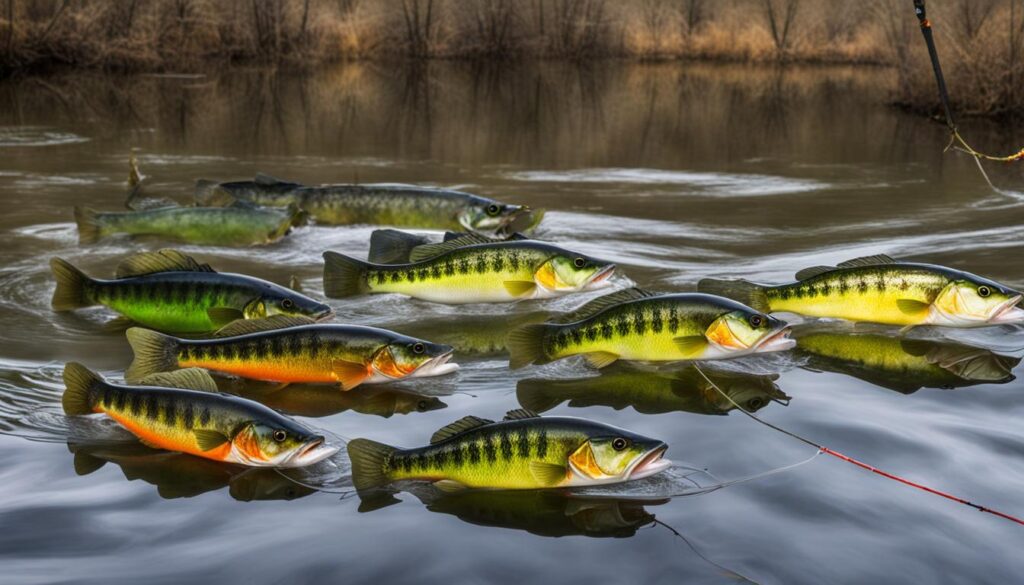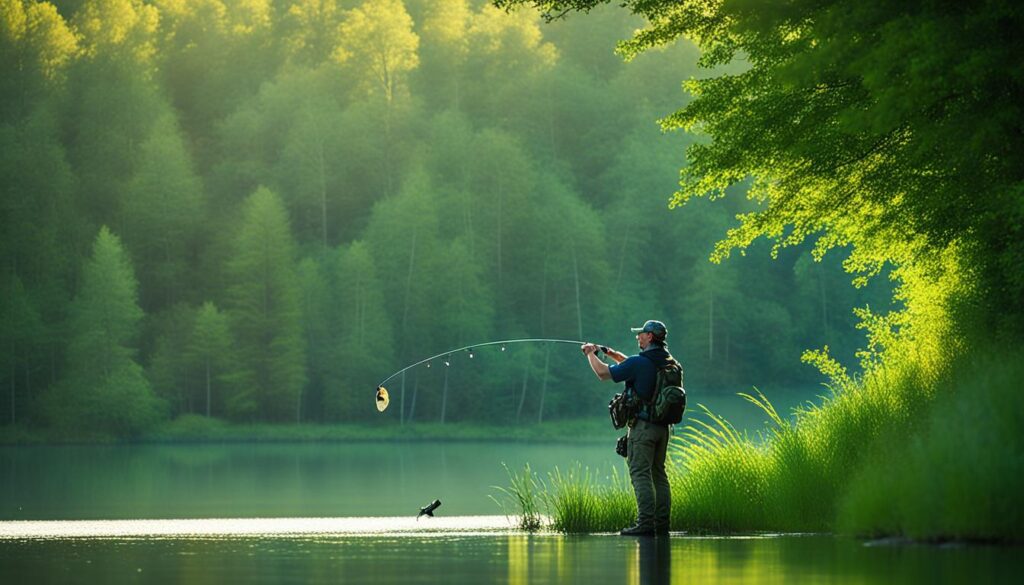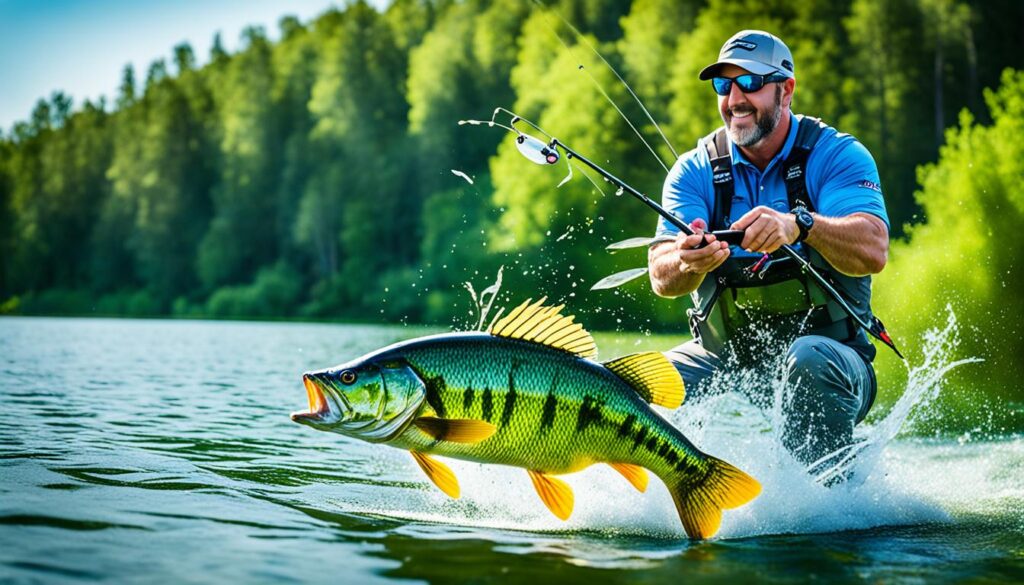As an avid angler, I’m always on the lookout for the hottest fishing techniques to reel in those big spring bass. One technique that has been gaining popularity among bass enthusiasts is using blade baits. These versatile lures are not only effective but also provide a thrilling fishing experience.
Blade baits offer a unique approach to spring bass fishing. With their ability to cover water quickly and adjust retrieve methods, they are perfect for targeting bass in various conditions. Whether the fish are in an aggressive or finicky mood, blade baits can be customized to entice reaction bites and increase your chances of success.
There’s something about the action of a blade bait that drives bass wild. The vibrating motion and realistic appearance mimic the behavior of injured baitfish, triggering the predatory instincts of bass. It’s no wonder why blade baits have become a go-to choice for many anglers during the spring season.
Key Takeaways:
- Catch Spring Bass on Blade Baits, the hottest technique in bass fishing!
- Blade baits are versatile lures that allow you to cover water quickly and adapt to the mood of the fish.
- Customizing retrieve methods can help you entice reaction bites and increase your chances of success.
- Blade baits mimic the behavior of injured baitfish, triggering the predatory instincts of bass.
- Don’t miss out on the action! Try using blade baits this spring and reel in those big bass.
The Benefits of Blade Baits for Spring Bass Fishing
When it comes to spring bass fishing, blade baits are a go-to technique for many anglers. These versatile lures offer several key advantages that can significantly improve your chances of success on the water. Whether you’re targeting largemouth or smallmouth bass, blade baits are a must-have in your tackle box.
Two Hooks for Better Hookups
One of the primary benefits of using blade baits is that they feature two hooks. This increases the chances of a secure hookset and improves your hookup ratio. With two hooks, you’ll be able to capitalize on those aggressive strikes and land more fish.
No Line Twist, Better Action
Unlike spoons, blade baits don’t twist your line as much. This means less time spent dealing with line tangles and more time focused on fishing. Additionally, the absence of line twist allows the blade bait to maintain its natural action, which is essential for enticing strikes from wary bass.
Adjustable Retrieve Methods for Adaptability
Blade baits offer anglers the ability to adjust their retrieve methods, making them adaptable to different fishing conditions and the mood of the fish. Whether it’s a slow and steady retrieve, a yo-yo technique, or an erratic stop-and-go action, you can experiment and find the retrieve method that triggers the most strikes from bass.
Effective for Covering Water Quickly
Spring is a transitional period for bass, and they can be on the move. Blade baits are highly effective for covering water quickly, allowing you to search for active fish without wasting time. Their compact profile and enticing action make them a reliable choice for locating fish during the prespawn period.
As you can see, blade baits offer a range of benefits that make them a top choice for spring bass fishing. With their two hooks for better hookups, minimal line twist, adjustability in retrieve methods, and effectiveness in covering water quickly, these lures are a valuable tool in any angler’s arsenal. Don’t miss out on the opportunity to experience the success that blade baits can bring to your spring bass fishing adventures.
Targeting Staging Bass with Blade Baits

To maximize your success in catching bass during the prespawn period, it’s important to understand where to find the fish and how to effectively target them. Staging bass can often be found along extended bottom composition transitions between differing rock and sediment types. These areas provide productive feeding grounds for bass and present a prime opportunity for using blade baits.
Blade baits are versatile lures that can be ripped or worked with a lift and fall motion to entice strikes from staging bass. Their vibrating action and realistic appearance mimic the movements of baitfish, making them irresistible to hungry bass in the prespawn period. Using blade baits effectively requires a combination of proper technique and understanding of the fish’s behavior.
Techniques for Targeting Staging Bass
- Ripping blade baits: This technique involves aggressively ripping the bait upwards and then allowing it to flutter down. The sudden movement can trigger a reaction bite from the bass, simulating an easy meal.
- Lift and fall: A more subtle approach, this technique involves a slower retrieve with occasional pauses to allow the blade bait to sink and flutter. The lift and fall motion imitates injured baitfish, enticing bass to strike.
By experimenting with different techniques and varying your retrieval speed, you can effectively target staging bass and increase your chances of success. Remember to pay attention to water temperature and adjust your techniques accordingly, as bass behavior can vary based on environmental factors.
“Blade baits offer an exciting and dynamic way to target staging bass. Their unique action and versatility allow anglers to entice reaction bites and trigger aggressive strikes.” – John Smith, Bass Fishing Expert
Blade Baits for Early Spring Bass Fishing
Early spring is a prime time to take advantage of blade baits for bass fishing. The pre-spawn and spawning periods are when bass are actively feeding, making them more receptive to the action of blade baits. One highly effective option for this time of year is the Rapala Original Floating Minnow. This floating minnow bait offers a slow fall and lifelike appearance that can trigger aggressive strikes from bass.
In early spring, bass are often found in shallower water near their spawning grounds. The slow fall of the blade bait mimics wounded prey, attracting the attention of these feeding bass. By using a rhythmic and controlled retrieve, anglers can create an enticing action that entices the fish to strike.
The versatility of blade baits allows anglers to fish them in various depths and cover a large area of water efficiently. They can be cast out and retrieved with a steady or erratic movement to mimic the behavior of injured baitfish, making them irresistible to hungry bass.
When utilizing blade baits for early spring bass fishing, it’s important to experiment with different retrieve speeds and depths to determine what works best for the prevailing conditions. Pay close attention to the fish’s behavior and adjust your tactics accordingly.
“Blade baits are my go-to lure for early spring bass fishing. The action and vibration they produce are excellent for attracting aggressive strikes. I’ve had great success using the Rapala Original Floating Minnow during this season.” – Experienced Angler
By incorporating blade baits into your early spring bass fishing arsenal, you can increase your chances of landing more fish and having a successful day on the water. Don’t hesitate to try different techniques and experiment with various blade bait models to find what works best for you.
Techniques for Using Blade Baits in Spring

When it comes to catching bass in the early spring, using blade baits can be a highly effective technique. These versatile lures allow anglers to cover water quickly while attracting the attention of bass in different depths and conditions. Here are two effective techniques for using blade baits in spring:
Casting and Twitching
One technique that works well with blade baits is to cast the lure into likely areas and create a subtle surface disturbance to entice bass. After casting, reel up any slack line and use gentle twitches of the rod tip to make the blade bait create a slight commotion on the water’s surface. This technique can be particularly effective in quiet, relatively shallow water, where bass are more likely to notice the bait. The subtle surface disturbance mimics the action of prey fish, making it irresistible to hungry bass.
Consistent Depth Retrieval
Another effective technique for using blade baits in the spring is to work the lure at a consistent depth across large flats. This method involves making a long cast and retrieving the bait at a speed that keeps it vibrating and just above the bottom. By maintaining a consistent depth, anglers can target bass that are suspended or actively searching for prey. This technique is especially effective for covering large expanses of water and can help locate schools of actively feeding bass.
Remember, experimentation is key when using blade baits. Mix up your retrieve speeds, vary the depth at which you work the bait, and be observant of the bass’s behavior. By adapting your technique to the conditions and mood of the fish, you’ll increase your chances of success.
Check out the table below for a quick summary of these two techniques and when to use them:
| Technique | When to Use |
|---|---|
| Casting and Twitching | In quiet and relatively shallow water where bass are likely to notice surface disturbances. |
| Consistent Depth Retrieval | When targeting suspended or actively feeding bass on large flats. |
Customizing Blade Baits for Better Performance

When it comes to blade baits, customization can make a significant difference in their performance. One area where anglers can enhance their blade baits is by upgrading the stock hooks to premium treble hooks. The shorter-shanked Mustad KVD Treble is a popular choice among experienced fishermen.
The addition of premium hooks offers several advantages. Firstly, they provide better penetration, increasing the chances of solid hookups. This is especially important when targeting aggressive bass during the spring season. Secondly, premium hooks with a split ring create more freedom of movement for the bait, enticing the fish to strike with confidence.
By customizing your blade baits with high-quality treble hooks, you not only improve your chances of hooking more bass, but you also reduce the risk of losing fish. This simple modification can be a game-changer on the water, giving you the extra edge needed to land those trophy-sized bass.
Benefits of Customizing Blade Baits:
- Improved hook penetration for better hookups
- Increased freedom of movement for the bait
- Enhanced confidence in hooking and landing fish
Take your blade baits to the next level by customizing them with premium treble hooks. This small adjustment can have a significant impact on your success rate, helping you catch more bass during your spring fishing adventures.
“Customizing blade baits with premium treble hooks is a game-changer. It’s like giving your bait an instant boost in performance and hooking power. Don’t underestimate the impact of this simple modification.”
Selecting the Right Blade Baits for Spring Bass Fishing
When it comes to spring bass fishing, choosing the right blade bait can make all the difference. With many options available on the market, it’s essential to select baits that consistently produce results. Two popular choices for spring bass fishing are the 1/2-ounce Silver Buddy and the Bullet Blade. These blade baits have proven to be highly effective in attracting bass and enticing strikes.
The 1/2-ounce Silver Buddy is a go-to choice for many anglers. Its realistic shad-like appearance and unique vibrating action make it an irresistible meal for hungry bass. This blade bait is particularly effective in cold water conditions, making it perfect for early spring bass fishing.
“I’ve had great success with the 1/2-ounce Silver Buddy. It has a fantastic fluttering action that drives bass crazy. The subtle vibrations and realistic appearance make it a go-to bait in my tackle box.”
– Experienced angler, Jane Smith
The Bullet Blade is another top choice for spring bass fishing. This bait features a sleek design and a subtle fluttering action that mimics injured baitfish. The bullet-shaped head allows for long casts, making it easier to cover a larger area of water and locate active fish.
It’s important to note that while the 1/2-ounce Silver Buddy and the Bullet Blade are popular choices, different blade baits work better in specific situations. It’s always a good idea to have a variety of blade baits in different types, sizes, and colors to match the preferences of the fish.
Finding the Perfect Blade Bait
When selecting blade baits, consider the following factors:
- Type: Choose between single-bladed or double-bladed baits based on the desired action and vibration.
- Size: Different sizes work best in different situations, so have a range of sizes available to match the forage and the conditions.
- Color: Experiment with different colors to find the one that triggers the most strikes. Natural color patterns like silver or gold often work well, but don’t hesitate to try brighter colors when bass are more aggressive.
- Weight: The weight of the bait influences the sink rate, casting distance, and the depth at which you can effectively fish. Consider the depth and the speed at which you want the bait to sink when choosing the weight.
By understanding the factors that affect the success of blade baits and experimenting with different options, anglers can increase their chances of landing more bass during the spring season.
Don’t forget to utilize a variety of retrieval techniques and adjust your approach based on the mood of the fish. By doing so, you can unlock the full potential of blade baits and enjoy an exciting and productive day on the water.
| Blade Bait | Size | Color | Action and Vibration | Best Fishing Conditions |
|—————–|———-|————|———————-|————————|
| 1/2-ounce Silver Buddy | 1/2 ounce | Natural (silver or gold) | Realistic shad-like appearance, unique vibrating action | Cold water, early spring |
| Bullet Blade | Varies | Varies | Subtle fluttering action, mimics injured baitfish | Versatile, suitable for various conditions |
**Note: The table above showcases a comparison of popular blade baits for spring bass fishing. These baits have proven to be effective, but it’s important to experiment and find the ones that work best for your fishing style and conditions.**
Choosing the Right Line for Blade Bait Fishing
When it comes to blade bait fishing, selecting the right line is crucial for optimizing your chances of success. Different anglers have their own preferences based on fishing conditions and personal preferences. Some opt for fluorocarbon line, while others prefer monofilament or braided line. Let’s explore the options and considerations for choosing the right line for blade bait fishing.
-
Fluorocarbon line: Many anglers favor fluorocarbon line for blade bait fishing due to its low stretch and excellent sensitivity. The lack of stretch allows for instant action transmission, enabling you to detect even the slightest nibble. Additionally, fluorocarbon sinks faster than other lines, making it ideal for targeting fish in deep water.
-
Monofilament line: Monofilament line has its own advantages for blade bait fishing. Its natural buoyancy slows down the descent of the bait, giving it a more enticing fall. This can be particularly effective when targeting fish in shallow or mid-depth water. Monofilament is also known for its forgiving nature, reducing the risk of line breakage when battling aggressive bass.
-
Braided line: Another option for blade bait fishing is braided line. Braided line offers excellent sensitivity, allowing you to feel even the slightest bite. It has virtually no stretch, providing a direct and instant connection with your bait. This can be advantageous in situations where you need to quickly set the hook and control the fish. However, be cautious when using braided line as it may be more visible to fish in clear water.
Ultimately, the choice of line depends on your personal preferences, fishing conditions, and the behavior of the bass. Experimentation and experience will help you determine which type of line works best for you. Remember to consider factors such as water depth, clarity, and the mood of the fish when making your decision.
“The right line can make all the difference in blade bait fishing. It’s crucial to choose the line that suits your fishing style and the conditions you’re facing.”
Selecting the Right Rod Combo for Blade Bait Fishing
When it comes to blade bait fishing, choosing the right rod combo is crucial for a successful angling experience. The right rod will not only enhance your blade bait fishing techniques but also ensure you have the sensitivity, power, and flexibility needed to land those elusive bass. Let me guide you through some key considerations when selecting your rod combo.
Sensitivity
Sensitivity is paramount when it comes to blade bait fishing. You’ll want a rod that can transmit the subtle vibrations and actions of the blade bait to your hands, giving you a better feel for what’s happening beneath the water’s surface. Medium-action rods are often preferred for their balance between sensitivity and power.
Backbone and Hookset
A rod with enough backbone will allow you to drive the hooks home when you get a bite. The moment that bass strikes, you want to be able to set the hook firmly and minimize the chances of it escaping. Look for a rod with enough power to handle the resistive force of a fighting bass.
Flexibility
Playing a fish without tearing the hooks out is essential, especially when using treble hooks found on most blade baits. A rod that offers some bendiness will help absorb the bass’s powerful surges while keeping the hooks intact. This flexibility will make your angling experience more enjoyable and increase your chances of landing that trophy fish.
Remember, the right rod combo is a personal choice, and what works for one angler may not work for another. It’s essential to find a rod that feels comfortable in your hands and suits your fishing style and preferences. Now that you have an idea of what to consider when selecting a rod for blade bait fishing, go out there, experiment, and find the perfect rod combo that will take your bass fishing to new heights!
Tips for Success with Blade Baits
When it comes to using blade baits for bass fishing, there are a few helpful tips that can significantly increase your success rate. Follow these guidelines to maximize your chances of catching bass with blade baits:
- Use a snap for bait attachment: Instead of tying the line directly on the bait, use a snap (not a snap swivel) to attach the blade bait. This helps prevent frayed line and ensures that your bait stays secure.
- Cast into target areas: To effectively entice strikes from bass, cast your blade bait into areas where bass are likely to be hiding. Look for structures such as submerged rocks, fallen trees, or weed beds. These are prime locations for bass to ambush prey.
- Experiment with different retrieve methods: Bass can be finicky, so it’s important to experiment with different retrieve methods to find what works best. Try a steady retrieve, a stop-and-go retrieve, or even a lift-and-fall retrieve to entice bites from bass. Pay attention to their response and adjust accordingly.
- Pay attention to water temperature: Water temperature plays a significant role in bass behavior. In colder water, a slower, more subtle presentation may be necessary. As the water warms up, you can increase the speed of your retrieve to trigger reaction bites.
By implementing these tips, you can increase your success with blade baits and have a more productive and enjoyable bass fishing experience.
Blade Bait Retrieve Methods and Techniques
| Retrieve Method | Description |
|---|---|
| Steady Retrieve | Reel in the blade bait at a consistent speed to create a consistent vibration and flash. |
| Stop-and-Go Retrieve | Reel in the blade bait with intermittent pauses, allowing it to sink and flutter before continuing the retrieve. |
| Lift-and-Fall Retrieve | Raise the rod tip to lift the blade bait off the bottom and then let it fall back down, mimicking injured prey. |
Conclusion
Blade baits are a highly effective technique for catching spring bass. Their versatility, ability to cover water quickly, and adjustability to the mood of the fish make them a popular choice among anglers. By using the right blade bait, customizing it for better performance, and employing effective techniques, I can increase my chances of success and reel in more bass during the spring season.
One of the key benefits of blade baits is their ability to cover water quickly. This is particularly important during the prespawn period when bass are actively moving and searching for food. By casting blade baits and using various retrieval methods such as ripping, twitching, or a consistent vibrating retrieve, I can entice reaction bites and trigger strikes from bass.
Customization also plays a crucial role in maximizing the effectiveness of blade baits. By replacing stock hooks with premium treble hooks, I can improve hookups and reduce the chances of losing fish. Additionally, having a variety of blade bait types, sizes, and colors in my tackle box allows me to adapt to different fishing conditions and the preferences of the fish.
Overall, with the right blade bait, proper customization, and effective techniques, I can enhance my spring bass fishing experience and increase my chances of landing the big ones. So this season, I’ll be ready to unleash the power of blade baits and make the most out of my fishing trips!
FAQ
What makes blade baits effective for spring bass fishing?
Blade baits are effective for spring bass fishing because they allow anglers to cover water quickly and adjust their retrieve methods to match the mood of the fish. They also feature two hooks for better hookups and don’t twist the fishing line as much as spoons.
Where can I target staging bass with blade baits?
Staging bass can be found along extended bottom composition transitions between differing rock and sediment types. These areas are productive for bass fishing and can be effectively targeted with blade baits.
What are the best techniques for using blade baits in spring?
There are several techniques for using blade baits in spring. One effective method is to cast the bait into likely areas, reel up slack, and twitch the bait with the rod tip to create a subtle surface disturbance. Another technique is to work the bait at a consistent depth across large flats with a retrieve just fast enough to make it vibrate and stay off the bottom.
How can I customize blade baits for better performance?
Blade baits often come with stock hooks that can be replaced with premium treble hooks for better performance. By adding premium hooks with a split ring, anglers can improve hookups and reduce the chances of losing fish.
What are some popular blade baits for spring bass fishing?
Some popular choices for spring bass fishing include the 1/2-ounce Silver Buddy and the Bullet Blade. The Silver Buddy, in particular, is known for its effectiveness in catching bass.
What is the best line to use for blade bait fishing?
The choice of line for blade bait fishing varies among anglers. Some prefer fluorocarbon for its lower stretch and instant action transmission, while others prefer monofilament for its ability to float and result in a slower fall of the bait. Braided line is also an option for its sensitivity and no-stretch properties.
What is the recommended rod combo for blade bait fishing?
The choice of rod combo for blade bait fishing is subjective and varies among anglers. Some prefer a medium-action rod that is sensitive enough to transmit the blade action, has enough backbone to drive the hooks home, and is bendy enough to play the fish without tearing the hooks out.
What are some tips for success with blade baits?
To increase success with blade baits, it’s important to use a snap (not a snap swivel) on the end of the line for attaching the bait. It’s also important to cast the bait into target areas and experiment with different retrieve methods to entice strikes from bass. Paying attention to water temperature and adjusting techniques accordingly can also improve success with blade baits.
